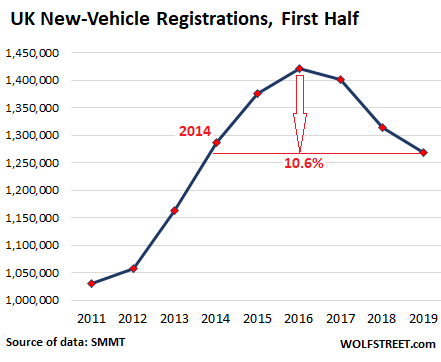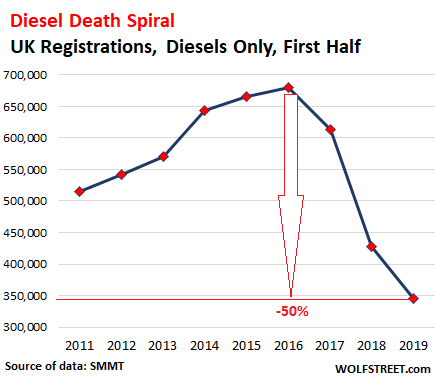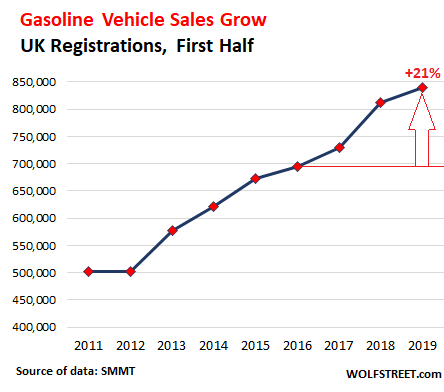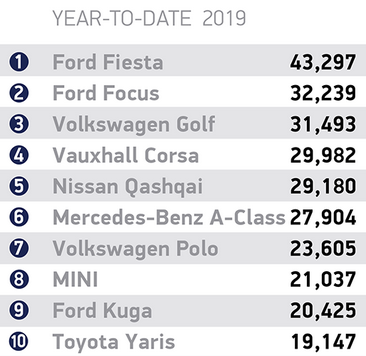Driven by Diesel Death-Spiral, “decline in buyer confidence,” plunging sales of plug-in hybrids. But EV sales soar.
By Nick Corbishley, for WOLF STREET:
Sales of new passenger vehicles, as measured by registrations, fell 4.9% in June from a year earlier in the UK, according to the Society of Motor Manufacturers and Traders (SMMT). The UK is the second largest auto market in the EU, behind Germany. Total sales in the first half of 2019 dropped 3.4% year-over-year, driven by the ongoing collapse in diesel sales. But sales of gasoline vehicles rose 3.5% in the first half, and sales of battery electric vehicles (BEV) soared 60%.
It is the third year in a row of declining first-half sales for the UK’s automotive sector. Since the peak in the first half of 2016, registrations have dropped 10.6%, falling below 2014 levels. These registrations include leases (dealer sells to leasing company, which leases it to the customer):

The growth in sales of gasoline-powered vehicles has picked up some of the slack from the diesel death spiral, but it’s not nearly enough. Since 2016, the first-half sales of gasoline vehicles have grown by 146,473, while sales of diesel powered passenger vehicles have fallen by 335,000 units, leaving a deficit of around 190,000 vehicles.
The diesel death spiral, not only in the UK but in Europe more generally, is a consequence of endless disclosures since 2015 of industry-wide diesel emissions fraud. In June, diesel sales fell for the 27th consecutive month in the UK. In the first half of 2019, diesel sales plunged 19.4% year-over-year, after having already plunged 30% in the first half of 2018 During the three years since hitting the peak of 680,668 units in the first half of 2016, diesel sales have collapsed by 50%, to just 344,877 units:

Sales of gasoline vehicles hit a new record of 840,436 in the first half of 2016. This was up 21% from 2016, but not nearly enough to compensate for the 50% collapse of diesel vehicle sales:

From January through June, sales fell for all three customer types: private customers (-4.8%), fleets (-2.5%), and businesses (-37.1%). There were also declines across every vehicle segment, except Dual Purpose which grew 7.3% year-to-date to take 22.6% of the market.
The so-called “supermini” (a small robust car) remains Britain’s favorite vehicle type, accounting for 31% of all registrations in the first six months. Below are the best sellers in the UK for the first half of 2019 (table via SMMT). Note that eight of the 10 best sellers were either small cars or superminis, the exceptions being two compact SUVs, the Nissan Qashqai and the Ford Kuga:

In the alternatively fueled vehicle (AFV) sector, the fates diverge:
- Demand for battery electric vehicles is robust: BEV sales soared 61.7% in June and 60% in the first half, but the numbers are still small: about 12,000 BEVs were sold in the first half, for a market share of under 1%.
- Things are not looking quite so rosy for plug-in hybrids, sales of which collapsed by 50% year-on-year in June and 30% in the first half, to 14,923 units.
- But sales of hybrids, while they fell 4.7% in the month of June, have soared 17% in the first half to 49,217.
“A grave concern,” is what SMMT CEO Mike Hawes called the decline in plug-in hybrids. “Manufacturers have invested billions to bring these vehicles to market but their efforts are now being undermined by confusing policies and the premature removal of purchase incentives.”
The decline in overall new vehicle sales — which the SMMT blames on “ongoing confusion over low emission zones and diesel, the removal of key ultra low emission vehicle incentives and an overall decline in buyer confidence” — is of major concern to global automakers. The UK is the second largest auto market in the EU, behind Germany. It is also the largest single export market for German automakers, which sold 800,000 new cars there in 2016 alone, or 20% of their overall global exports.
Reasons abound for the UK car industry’s multiyear decline, including broad consumer distrust of diesels in Europe and stagnating consumer and business demand in the UK, due in part to the pervading uncertainty surrounding Brexit. But as tempting as it may be, especially for some, to pin much of the blame for the industry’s malaise on Brexit, it’s worth bearing in mind that auto sales have been falling across the EU and other markets, including the two largest, China and the US, and they’re not facing Brexit.
Last year global car sales declined slightly for the first time since 2009, largely driven by a steep decline in China. They’re expected to fall more sharply this year. As car manufacturers reel from an array of disruptive forces — including tectonic technological shifts, trade wars, the end of Europe’s love affair with the diesel engine, and the waning appetite for new vehicles among cash-strapped, debt-laden consumers — one thing is becoming clear: Now is not an easy time to be in the car industry, wherever you are. By Nick Corbishley, for WOLF STREET.
In the US, big equipment is hot and gets pricier. But Carmageddon for cars. Read… New-Vehicle Sales Fall to 1999 Levels: How to Grow Revenues After 20 Years of Stagnation (Yup, You Guessed It)
Enjoy reading WOLF STREET and want to support it? You can donate. I appreciate it immensely. Click on the mug to find out how:
![]()


I wonder if public transportation, car leasing, online shopping, grocery delivery services, electric scooters and Uber are disrupting auto sales. It seems more like a cyclical downturn. Real estate markets in most Australian and Canadian cities are downtrending.
Those scooters are a real pain in the ass, toodling along too fast on the sidewalks etc., but the riders seem to be slowly gaining skill, and every scooter is one less Uber or Lyft or cab, or people coming downtown with their car.
Cars are very expensive to own and operate in Europe. Getting a drivers license cost several thousand dollars in Germany. Filling up the tank is nearly $100.
So my bet is on the cash strapped consumers reason.
#####
As car manufacturers reel from an array of disruptive forces — including tectonic technological shifts, trade wars, the end of Europe’s love affair with the diesel engine, and the waning appetite for new vehicles among cash-strapped, debt-laden consumers
+1
Yep, in the UK, petrol (Gasoline) is on average approx $6 a US Gallon and increasing.
I personally would never even consider buying/leasing a new car and always buy used. However .gov vehicle testing now getting increasingly stringent, particularly with emmissions, is making it harder to keep an older car on the road….
Just a check engine light illuminated after start up is now a failure.
Germany, I believe is even worse, which I have heard they are proposing that a failure will be even if the tyres are not OEM years later!!
Apparently you can tax & regulate them out of existence.
Soon, only the rich will be able to drive a fiesta….and of course the
regulators.
Astute you are. But you serfs will be allowed to drive a Lamborghini in an on-line game.
I had my first journey in an electric vehicle recently – a new Nissan Leaf. The owner lives 18 miles out of town and picked us up on the way to a city restaurant. The ride was pleasant enough except the car was cold and the windows were fogged. We asked if the heater could be switched on.
‘Sorry, can’t do that’ was the reply. It was explained that with 3 passengers and a round trip of 40 miles, even starting with a full charge, he wouldn’t have enough battery power to use the heater and get home.
That was a surprise. I imagine that would be a problem if you are caught in long traffic delays and can’t use the A/C. I saw an advert for a E/V with solar panel accessory but I don’t know if that is a solution. E/V is the future but some work to do on battery power.
I lived in UK until 1970 and in those days it was a status symbol to own a car with the latest year letter on the registration plate. I wonder if that is still a motivator for new car sales.
Mr. Martin, putting solar panels on top of any EV without regard to what its owner needs is extremely stupid. It should be optional.
Take the new car “Sion” from German Sono Motors for example. 7,5 sqm. of solarpanels on the roof, doors, hood giving a nominal capacity of 1,2 kilowatts of charging under ideal conditions (sun shining directly on the panels from a high angle) which will never be meet among other things because the angle of the car never will be matching the sun for optimal charging.
To make good use of them anyway you need to park your car outside, not in a garage. Not very practical for many of us.
In northern latitudes solar panels have an average capacity factor of only 10-12% over the year, most in the summer and extremely little in the winter when your EV actually consumes the most electricity. The producer of “Sion” claims the solar panels are able to extend the range with up to 30 kms/19 miles a day under ideal conditions. I suspect that`s only achieveable in very sunny countries or regions, preferably from 0 to 30 degrees latitude.
Solar panels are expensive, but they have a life span of 25-30 years at least, much more than the average car. A big waste when the car is scrapped. In most cases those panels should be on your house or garage instead.
Sion has 2 markets.
a) Virtue signaling. But that is true of almost all cars Especially expensive cars
b) Estate cars.A car that only runs within an estate/private island You only drive 10 miles a day with it so the sun is enough to recharge it enough that you only need to recharge it during maintenance. As a fast golf buggie
Using say a 30kWh Leaf, the range is circa 107 miles according to the EPA. So that is 3.56 miles/kWh.
7.5 m2 of panels is equivalent to a 1kWp system, give or take. This will generate ~5-6kWh per day under optimum conditions in summer. So that is where the 19 miles claim comes from.
However if stated with no caveat, it is purely dishonest. You can see the output for a 4.77kWp unit in the link below over the month of May 2015, and it is variable (last graph in the article). To this, we also have to account for the crap angles some of these panels will be on the car. You certainly will not be getting that range boost in summer, never mind winter.
https://elkement.blog/2015/06/17/solar-power-some-data-for-the-first-month/
“E/V with solar panel accessory” we can’t go dumber than that!
Solar panel for a car is a great ideal for running a ventilator so it is not 90C when you enter. This is also true for ICE cars.
By “ventilator” what do you mean?!
If it is what I’m thinking… it’s even dumber.
The easy solution for the “90C” “problem”… just open the doors and wait a little!
The 2019 Nissan Leaf has a range of 225 miles. The 2018 model has 151 miles. Hard to believe the vehicle won’t do a 40 mile round trip with or without the heater. I have an EV with a 265 mile range and almost daily make 150 round trips in all weather conditions and usually have 100 miles range left.
Purely electric cars–plug-ins–have always seemed to me to be an expensive hoax. They pass their emissions on to the power plant, and you pay for something that a genuine hybrid (gasoline plus electric) can make. You encounter the problems you have mentioned in heat or cold. I suppose the windows frost up while you freeze to death in the winter). The internal combustion engine in a real hybrid provides power when the electric component is insufficient.
Diesel engines pollute more than gas engines, that is why manufacturers have to cheat on American pollution standards.
Diesel engines create a great deal of dirt within the engine and when you change the oil you can feel the grittiness. You will usually see the smoke they create as all the diesel does not get completed burned. Diesel is usually priced similar to 93 grade gas. No longer cheaper than gas like it was 50’s to late 70’s.
I will never buy another diesel as you have to change the oil every 3-4000 miles. Besides the grit, the oil becomes very black in that short oil change interval. Also that engine is noisy. Opposite end of EV’s.
Seems odd
A new leaf has 60kwh of battery and consumes about 3.5 miles per kWh
So for a 40 mile trip they should have 45 kWh of battery
Now if this is Juneau Alaska in February maybe it’s 40 below and the battery is fading hard especially sitting at a restaurant for three hours but usually you plug in and warm the battery
Strange that all these “climate change” consumers aren’t going for electrical engines…
Hybrids are the answer for that, but I am showing my suspicious age when I say I am afraid of the maintenance costs and battery issues of all these new cars, including dynamic braking and all the sensors. My God, there is a whole generation of ignorants out there who do not know how to check tire inflation and fluid levels.
Plus, there is proprietary software forcing consumers to rely on brand maintenance facilities.
Problems are not usually solved with layering on more complexity. One day people will accept that owning an auto and air travel is a luxury when there are better alternatives like transit and rail. That day might take fuel approaching the cost of bottled water to wake us up. Until then…..
We sometimes drive a 2009 Yaris and an ’81 Westfalia. :-)…. Unlicensed ’86 Toyota for hauling wood, etc.
My grandson bought a used Prius for $1500 that had a dead hybrid battery. He swapped the battery for a new one from Toyota, did a brake job, and replaced the tires. He ended up with about $3,500 in the car.
He now has a commuter car that gets ~50 mpg.
I have a Toyota Yaris Verso from 08/2002! Still doing fine.
Only normal maintenance (oil/filter).
The brakes are the original material (and still with 85% efficiency)… True not many miles (+-130.000 kms / +- 80,778 miles) which gives +-7.600 km/year or 4,722 miles/year). Even the AC never went for maintenance and still works fine!
And I have no intentions to switch to these electronics nightmare!
EVs are great if
a) you never drive more than 30 miles from home
b) you don’t live in a cold climate
c) you don’t have anything to tow
d) you don’t need much space for kids, pets, etc
In other words, millenials in warm climates. Problem is millenials in warm climates don’t drive. Or if they do drive, they live in apartments/condos without access to a place to charge the cars. A nasty catch 22 for EV makers and their boosters.
This represents nothing more than a great deal of unexamined prior assumptions and biases.
1) EV range is several hundred miles now.
2) We do have garages in Alaska as well as plug ins for car heaters.
3) I see people here in Anchorage towing things with hybrids and pure electric vehicles fairly often. Not 100 foot fifth wheelers to be sure, but R pod campers, kayaks, four wheelers, etc. Cheaper to hire someone to tow these things or to rent a V-10 pickup or RV from ABC Rentals (my preferred rental place for giant things).
4) Kids are small. If you are a megabreeder you probably weren’t going to go smaller anyway-even the Partridge family drove a huge bus.
There are millenials everywhere and they are sweating it out right now wondering if this is the End Times we were promised by the kooky Evangelists and GOPeople who seem to be doing everything they say is bad. There are plenty of outdoor plug ins here and it is more efficient in resources to use the mix of hydroelectric and natural gas to make a lot of energy than it is to have thousands of gas and diesel engines warming up, sitting at traffic lights, revving in drive through lines, accelerating and stopping in traffic and so on.
It won’t save the world but it is at least a step away from the Thelma and Louise approach we are currently operating under. If Subaru or Audi made an AWD all electric with a winter thermal manager I would be in line.
To Just Some Random Guy (JSRG),
I agree with EchoDelta, regarding your assumptions on the performance or suitability of EVs.
Yes, for now, EVs are more effective for commutes within urban areas, largely because of the “range anxiety” and due to the lack of charging infrastructure.
Your 30 miles is nonsensical and misleading. The average range for current EV models, on a full charge easily exceeds 100 miles conservatively.
There are also companies that sells reasonably cheap converters (aka ACDC transformers) for your EVs that tap into existing electrical outlets in your garage for overnight charging purposes.
http://www.pluginindia.com/blogs/bharat-ev-specifications-for-ac-and-dc-charging-everything-you-need-to-know
If your house already has solar panels, adding a battery storage system could potentially reduce your cost er mile to near negligible.
(I’d reckon the petroleum companies will hate that for sure )
For those unapologetic millenials of yours, living in condos and apartments; I’d agree that for now, having sufficient charging stations for the building, is a challenge but not because of technical difficulties, but rather of utility cost allocation to residents and basically waiting for sufficient numbers of residents to have EVs before there is collective will to push for such installations.
This is the classic chicken-and-egg problem.
Right now, there is insufficient folks using EVs, so there is lack of political will to install chargers in condos/apartments, which in turn becomes a disincentive to purchase an EV.
With EV battery technologies increasing by leaps and bounds over the past decade and into the future, I forsee that EVs will increasingly displace ICE engines for reasons many folks have already listed here.
PS: To JSRG, you still have not answered to my earlier question, on the website link to the leasing company where you got the apparently fantastic no-money-down BMW 5 series leasing deal. lol.
Btw, for those US-centric readers, note the Scandinavians are already charging ahead in terms of EV adoption.
And contrary to what “Just Some Random Guy” said, their Scandanavian calendar is like having 8 months out of the year being shrouded in cold and they have large suburban populations who travel more than 30 miles each day too.
Yet, in Norway’s case, they have successfully transitioned to EVs even when one-fifth of their economic GDP is dependent on oil exports.
https://www.wired.com/story/norway-electric-vehicles-tourism/
When I pedal my bicycle, I’m using chemical energy, which any chemist or physicist will tell you is based on the electrical properties of atoms – think back to chem class and counting those electrons and protons and such.
Thus, I have very much gone for using an electrical engine.
Western policy makers rearrange the deckchairs to look in control.
It’s a dead giveaway to knowing the wheels are about to come off the bus.
By around 2022 BEV vehicles will be cost competitive with gasoline vehicles without subsidies. The revolution is at hand.
It just a different type of ECOLOGICAL destruction… so in the end not quite a “revolution”!